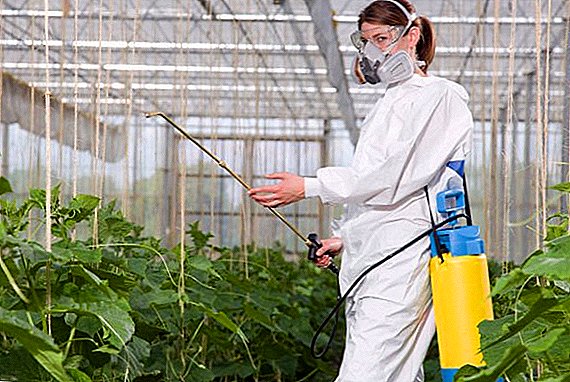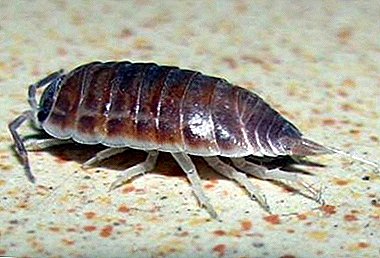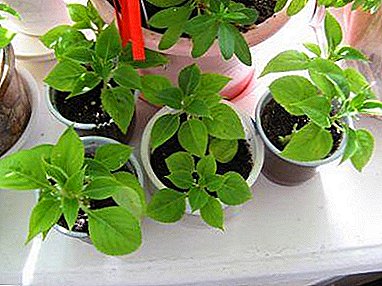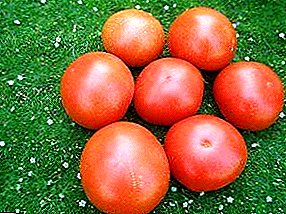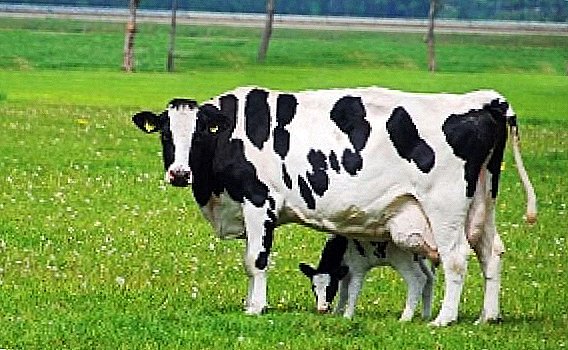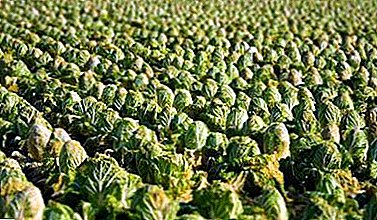
Cabbage - a plant of the genus Cruciferous. It can be different - red and white, Brussels, color, Beijing and other species, and to grow them in the country it is important to know how to do it correctly.
In the article we will describe how to plant vegetables with seeds, as well as how to grow any of these plants in the open field. We give recommendations for the care of young white cabbage, as well as demonstrate the photo. In addition, you can get acquainted with useful and informative videos on the topic.
Features
Growing cabbage in the open field requires attention. Especially when the first shoots appear. During this period, the plant may be attacked by pests that can destroy sprouts in a couple of hours. In order to protect a plant, there are two ways:
- Daily inspection. If holes are seen on the leaves, you need to cover the area with ashes.
- Pre-close the cabbage film. Along with this, you can do chemical processing.
Board: do not forget about the inspection of the leaves. It is necessary to monitor the humidity of the earth.
Cabbage - light-loving plant, so the site should not be in the shade. It is not advisable to plant it after turnips, beets, tomatoes and radishes. Cabbage is not suitable acidic soil. In this case, you need to make a liming of the soil. It is necessary to prepare the land for cultivation in the fall. Soil is fertilized with humus or manure and dug over. In the spring, peat and wood ash are added to the soil.
How to grow seedlings?
How to grow, for example, white cabbage, to plant it in the country and the harvest was good? At home, germinate seedlings, and then transplanted into greenhouses. When grown in open ground sprouts are planted in open soil. Preliminary need to prepare inventory. You will need containers for soaking seeds, paddle, gloves, as well as a watering can.
Seed preparation and germination
 If the seeds were collected independently, they are first kept no more than 20 minutes in hot water, the temperature of which is approximately 50 degrees. Then placed for a few minutes in cold water and dried. Pre-preparation is not necessary for purchased seeds, it is carried out by manufacturers..
If the seeds were collected independently, they are first kept no more than 20 minutes in hot water, the temperature of which is approximately 50 degrees. Then placed for a few minutes in cold water and dried. Pre-preparation is not necessary for purchased seeds, it is carried out by manufacturers..
For seed germination using loose soil with a large admixture of peat. Requires moderate watering. Need to use extra lighting. The room in which there are seeds, need to be aired.
Cabbage will grow slowly in the first two weeks. The first leaves will appear in six weeks.
You can sow seeds in boxes or special peat pots. Begin to grow seedlings in the last days of March. Sowing is carried out by large seeds. This will increase the yield.
We recommend to watch a video about growing seedlings of cabbage from seeds:
Planting in the garden
When to plant seedlings? Planted seedlings can only become stronger, which appeared dark green color. The planting scheme is not complicated - the holes for seedlings should be at a distance of 60 cm. They are watered and fertilized with wood ash mixed with soil. Then water again.
The landing is carried out on an overcast day or in the evening. When planting, the plant is buried in the ground to the first true leaf. The roots and stem well compressed soil.
After planting, seedlings should be shaded for 3 days.so that she better settled down.
We recommend to watch a video about planting cabbage seedlings in open ground:
Care for young vegetables
- Watering. Watered cabbage every day - in the morning and in the evening with water, with a temperature of 18 degrees, preventing it from drying out. The intensity is adjusted depending on the weather.
- Top dressing. Two weeks after transplanting, it is fed with phosphate fertilizers. You can use chicken dung and manure. After two weeks, another feed is carried out with the same ingredients. Further fertilizer is carried out as needed.
- Hilling. To carry out hilling need a manual hoe or hoe. At a distance of 20-25 cm from a seedling in a circle, they rake up the ground to the stalk. You can not fall asleep growth point. With this method, struggling with cabbage fly. Hilling is usually done 40 days after transplanting. Further earthing up is carried out every two weeks, and finish when the cabbage spreads the leaves.
Mulching
Mulching - covering the earth with a protective layer. The advantages of the procedure:
 reducing the frequency of irrigation;
reducing the frequency of irrigation;- weed control;
- the soil remains loose;
- protection of the soil from leaching of the top layer during heavy rain;
- The soil is enriched with nutrients.
Before mulching, weeds are removed and soil is loosened.. Do not lay mulch on cold ground. The thickness of the layer is 2 - 8 cm, depending on the material. It is cheaper to use different plants and their residues.
Mulching is carried out using the following plants:
- Perfect rye. When the cabbage grows up, the rye is cut and the resulting straw is left on the soil surface. Decomposing, the straw will feed the cabbage with nitrogenous compounds.
- Nettle, cut grass, hay, straw.
- Sawdust. This material has a negative effect on the pathogenic flora.
- Peat and compost. Compost also serves as a fertilizer.
There is such a thing as inorganic mulching. To do this, use plastic film: transparent or black. The choice of material depends on the season. Black film is used at the beginning of planting, it is left for 3-4 weeks. Transparent film is chosen in the summer. As a result, weeds will not appear in the garden.
Harvesting and storage
Important: Harvesting is done as the cabbage matures. The main thing is to prevent cracking. If late varieties are sown, they can be left until the first frost.
White cabbage is collected in dry warm weather. If the harvest was collected in the rain, it must be dried and sent to storage.
Collected cabbages can be stored in the following ways:
- Hanging in the basement. The storage is pre-cooled to 0-1 degrees and must be aired.
- Rearing. Plants are transferred to the basement and placed in boxes or just on the floor, covered with earth, sand or peat. Moisturize the soil for two months. The temperature is maintained within three degrees. This method will allow heads to get stronger and gain weight.
- Storage in holes or trenches. Straw and cabbages are put on the bottom of the store. Crop harvested to freezing land. This method of storage, allows you to keep the cabbage fresh for three months.
We recommend watching the video about harvesting and storage of cabbage:
Diseases and pests
Cabbage, like all vegetable crops, unfortunately, is affected by a large number of pests and diseases that require special control measures.
 The most common pests are:
The most common pests are:
- Cruciferous flea. The cabbage leaves are amazing. They can also damage the growing point, which leads to the death of the plant. The larvae have a light yellow color.
Methods of struggle: spraying insecticide seedlings. With the mass appearance of the pest, pollination is carried out with tobacco dust and ash in the ratio of 1 to 1. The treatment interval is 4 days.
- Cabbage Mole. The caterpillars mine leaves, leaving the epidermis of the upper side of the leaf untouched in the form of a “window”. Often damage the growing point and the forming head, weaving it with cobwebs. Great harm is caused in the dry season.
Methods of struggle: treated with chemical or biological preparations.
- Cabbage Whitefish. A favorable period for the appearance of the pest is the hot and dry season. Damages the leaf plate and the inside of the heads. Caterpillars are green with a yellow stripe along the back.
Methods of struggle: same as when the cabbage moth.
- Cabbage scoop. Causes significant damage to the crop. It affects the leaves and heads, making deep moves in them.
- Cabbage Fly. Damage the roots.
Methods of struggle: treatment of marginal bands of fields with tobacco dust with slaked lime or ash.
- Stem Covert. Damages seedlings. Suffering leaves and stems.
Methods of struggle: treatment with insecticides.
- Cabbage Aphid. With the mass appearance of leaves covered with aphids, which sucks the juice from the plants. Heading out is not formed.
Methods of struggle: weed control, insecticide spraying.
Cabbage can be affected by all types of plant diseases caused by fungal, bacterial and viral pathogens.
- The most common disease is blackleg. Root neck is affected. The seedling dries up.
- Kela cabbage. Fungal disease as a result of which growths appear on the roots. Heads are not formed.
- Downy mildew. Yellow spots appear on the affected leaves.
- Alternaria. Initially, black spots appear on the leaves, and then covered with bloom.
- Bacteriosis or black rot most dangerous for cabbage. Small dark spots appear on the leaves.
We recommend watching a video about cabbage diseases and ways to deal with them:
Conclusion
When growing cabbage can be a lot of problems. However, this should not scare. With certain knowledge you can get a big harvest.


 reducing the frequency of irrigation;
reducing the frequency of irrigation;

